6.8 Fireplaces, chimneys and flues
SCOPE
DESIGN STANDARDS
Design that follows the guidance below will be acceptable for fireplaces, chimneys and flues.
In this Chapter a number of terms are used. Details are given in Appendix 6.8-C.
STATUTORY REQUIREMENTS
Design should be in accordance with relevant Building Regulations and other statutory requirements.
GENERAL CONSIDERATIONS
The design of dwellings which incorporate chimneys and flues should ensure that all details of the associated elements are considered and, where necessary, provided. This should include the following:
- combustion air supply
- constructional hearth
- chimneys and flues, including where they project through the roof
- terminals
- construction adjacent to hearths and flues
- limitations on the type of appliance or open fire which can be installed or fuel which can be used.
Where a chimney or flue is provided it should be continuous from the hearth or appliance to the outside air.
A notice plate containing safety information about any hearths and flues should be securely fixed in an unobtrusive but obvious position within the home.
Solid fuel
FIREPLACES AND HEARTHS
Where appliances are not provided, it is important to construct fireplaces and hearths to suit the appliance most likely to be fitted.
Items to be taken into account include:
Combustion air is vital to the safe and efficient operation of appliances. Solid fuel appliances should have an air supply either directly or indirectly from the external air to comply with statutory requirements and manufacturers' recommendations. Reference should be made to Appendix 6.8-A.
HEARTHS
Constructional hearths of sufficient dimensions should be provided for open fires or closed combustion appliances to comply with statutory requirements and manufacturers' recommendations. The dimensions shown in Clause S2 are for a concrete hearth at least 125mm thick below an open fire.
The hearth for a freestanding appliance should have minimum dimensions of 840mm. The following diagram shows the minimum dimensions from the appliance to the edge of the hearth.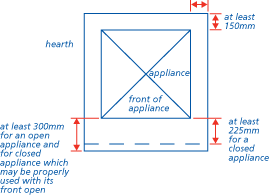
RECESSES
Recesses for open fires or closed combustion appliances should be provided to comply with statutory requirements and manufacturers' recommendations. Appendix 6.8-C gives some recess dimensions. The diagrams in Clause S2 show minimum masonry thickness surrounding the fireplace recess. Recesses are generally lined with a fire back or fire bricks.
For recess openings up to 500mm x 550mm, a 200mm diameter flue or square section of equivalent area can be used. For openings larger than this the flue size should be 15% of the area of the recess opening.
WALLS NEAR APPLIANCES
Walls near an appliance or its hearth should be non-combustible or the appliance should be positioned not closer to the wall than shown in the following diagrams.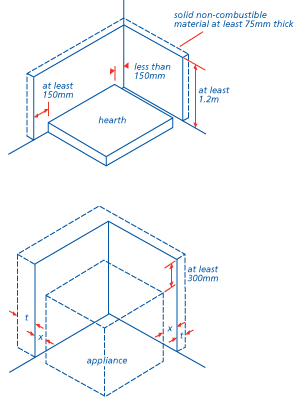
FLUE PIPES
Items to be taken into account include:
Flue pipes should be equal to the cross-section of the outlet of the appliance they serve.
Flue pipes for solid fuel appliances should be vertical or inclined at 45° or less from vertical. A short horizontal section not exceeding 150mm long may be used to connect a back outlet appliance to a flue.
Flue pipes which have spigot and socket joints should be fitted socket up.
Flue pipes should be separated from combustible materials by at least the following:
- 200mm of non-combustible materials, or
- an airspace at least 4 times the diameter of the flue pipe, or
- shielded by a non-combustible shield at least 3 times the diameter of the flue pipe in width. The shield should be at least 12mm from the combustible material and the combustible material at least 1.5 times the diameter either side of the flue pipe.
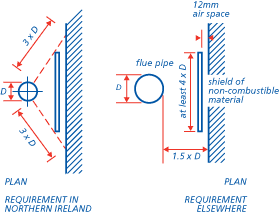
CHIMNEYS AND FLUES
A notice plate containing safety information about any hearths and flues should be securely fixed in an unobtrusive but obvious position within the home.
Items to be taken into account include:
A flue should serve only one appliance. Flues should be of sufficient cross sectional area to remove all combustion gases from the open fire or appliance they serve.
Appendix 6.8-B gives flue sizes for:
- open fires
- solid fuel appliances.
Flues for solid fuel appliances should:
- be vertical where possible but not have more than two bends
- not have bends more than 45° from the vertical
- be not less than 4.5m high for solid fuel appliances measured above the fireplace opening.
Combustible materials close to any brick or blockwork chimney should be:
- at least 200mm from the inside surface of a flue, or
- in all areas except Scotland, 40mm from the face of the chimney.
This does not apply to a floorboard, skirting, dado or picture rail, mantelshelf or architrave.
Materials used for chimneys should be capable of resisting fluctuating temperatures up to 1100°C. Suitable materials are described in the Materials section of this Chapter.
Flues for solid fuel appliances should be formed within masonry walls at least 100mm thick or 200mm thick if separating the flue from another compartment of the same building, another building or another dwelling. In Scotland, suitable masonry materials are described in the Building Standards (Scotland) Regulations.
Flues in the same chimney should be separated by masonry at least 100mm thick.
Timber framed wall design should include full details of separation proposals.
Flue liners should:
- have rebated or socketed joints with socket or internal rebate uppermost
- be non-combustible
- be reasonably smooth internally
- be correctly jointed with mortar with the space between the liners and the brickwork filled with weak insulating concrete unless the manufacturer recommends an alternative specification
- incorporate compatible purpose made bends at changes of direction; cut pipes are not acceptable
- be properly jointed at their junctions with the starter block or lintel and the outlet terminal.
Where a chimney is not directly over an appliance or opening, a soot box accessible for emptying should be formed.
Clay brick chimneys above roof level which are not protected by a capping with adequate overhang and drip should be constructed with F2,S1 or F2,S2 bricks to BS EN 771 bedded in mortar of 1 : ½ : 4 to 4½, cement : lime : sand or 1 : 3 or 4, cement : sand with plasticiser (see Chapter 6.1 'External masonry walls', Appendix 6.1-C). In Scotland, all external facing brickwork should be constructed using frost resistant bricks.
Sulfate resisting cement should be used in the mortar where flue gases are liable to affect the masonry, eg above roof level.
If external chimneys built with clay bricks of F2,S1 designation are rendered, sulfate resistant cement should be used.
Cavities in Very Severe and Severe exposure areas should be continuous up to roof level. This only applies below roof level where the stack forms part of an external cavity wall and applies to the complete structure including the fireplace recess. Where the chimney breast is gathered in, the lower projecting masonry should be protected against damp penetration with a suitable capping and cavity trays. Reference should be made to Appendix 6.8-C for typical construction details. Alternatives may be suitable.
Above the roof, chimney dpcs should link with flashings. Two dpcs should be used at suitable levels when the roof is steeply pitched, that is where the difference in level between the lower and higher intersection of the chimney with the roof will be more than 450mm. Lead trays should be protected with a thick coat of bitumen or bitumen paint where in contact with mortar. Plastic dpcs are not suitable. Weatherproofing details are included in Appendix 6.8-C.
Face brickwork above roof level should not have recessed joints.
If chimneys are to be rendered, the rendering should be as described in Chapter 6.1 'External masonry walls'.
FOUNDATIONS
Where a chimney forms part of a wall, the foundation should project at least 100mm wider than the chimney base. Where the chimney will exert higher loading on the supporting sub-soil than the adjacent wall, the chimney foundation spread should be designed to avoid uneven settlement. The depth of chimney foundations should be the same as adjacent wall foundations.
HEIGHT
The height H of an unrestrained chimney should not exceed 4½ times the least plan dimension of the chimney, W (see diagram in Clause S4), provided the density of the masonry is at least 1500kg/m3, unless designed by an Engineer in accordance with Technical Requirement R5.
This type of chimney should be designed in accordance with BS 4543 and BS EN 1859 and installed in accordance with BS 7566 or be assessed in accordance with Technical Requirement R3.
An operating life of at least 30 years is required.
CHIMNEY TERMINALS
Items to be taken into account include:
(a) position of the outlet
Outlets should be positioned as shown in Appendix 6.8-D. Refer to approved Document J where roof coverings are easily ignitable.
(b) pressure zones
The design should, where possible, allow for the effects of adjacent trees, buildings etc. on the "low pressure" zone as the efficiency of the flue may be affected.
A low pressure zone generally occurs on the lee side and at the ridge of a pitched roof and close to the windward side of a flat roof. The flue will generally function more effectively if the outlet is in this zone, taking account of prevailing winds.
Where down-draughts occur, for example on hillsides or near tall trees and buildings, the height of the flue outlet may have to be increased or a fan assisted flue installed.
(c) terminals
Terminals may be purpose-made components, built into the top of the chimney to a depth of not less than 125mm into the masonry or one-quarter the length of the terminal, whichever is the greater. The terminal should be sealed to the flue liners. The top flue liner projecting at least 20mm above the chimney capping is an acceptable terminal.
(d) chimney cappings
Chimney cappings should be designed to protect the masonry below. Cappings should preferably be monolithic slabs, weathered, projecting at least 50mm with a drip to shed water clear of the masonry. Brick chimneys which do not have this type of capping should be constructed using frost resistant masonry.
All external face brickwork in Scotland should be constructed using frost resistant bricks.
Cappings may be designed as a cover slab supported on piers to reduce the rain penetration into the top of the flue. The height of the supporting piers should be sufficient to allow a total free opening area at least twice the area of the flue outlet.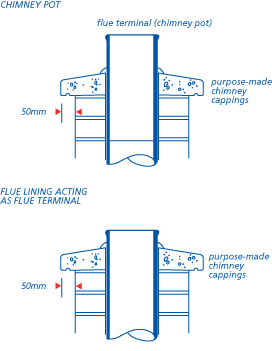
Gas
FIREPLACES AND HEARTHS
Items to be taken into account include:
Combustion air is vital to the safe and efficient operation of appliances. Requirements for combustion air are given in Appendix 6.8-A.
SOLID FUEL EFFECT APPLIANCES
Hearths and recesses for solid fuel effect appliances should be as described for solid fuel installations or in accordance with BS 6714 or BS 5871 or the manufacturer's instructions when the appliance has been tested by an approved authority.
BACK BOILERS
Hearths for back boilers should be constructed of solid non-combustible materials at least:
- 125mm thick, or
- 25mm thick placed on non-combustible supports at least 25mm high.
The diagram below shows minimum projections for the hearth beyond the appliance.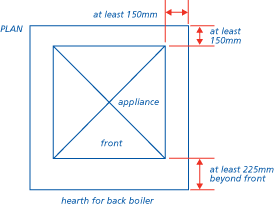
ALL OTHER GAS APPLIANCES
Hearths for other types of appliance should be at least 12mm thick non-combustible material to the same plan dimensions as above. In some cases the provision of a hearth is not required, for example if the flame or incandescent material is at least 225mm above the floor.
Where a hearth has been provided, its edges should be marked to provide a warning to the home owner and to discourage combustible floor finishes such as carpet from being laid too close to the appliance. A way of achieving this would be to provide a change in level.
Appliances should not be closer than 75mm to combustible material. This applies to the back, sides and top of the appliance and any draught-diverter. It does not apply if a 25mm thick non-combustible shield is used or the appliance complies with the appropriate parts of BS 5258 or BS 5386.
FLUE PIPES
Items to be taken into account include:
Flue pipes should be at least the area of the outlet of the appliance and have no adjustable draught control.
Apart from balanced flues, horizontal runs should be avoided. No pipe should exceed 45° with the vertical.
Flue pipes with spigot and socket joints should be fixed socket up.
Purpose-made connections should be used particularly in roof spaces when connecting to flue blocks and to ridge terminals. The connecting flue pipe should be supported on straps at centres not greater than 1.8m and have support directly below each socket.
Single wall flue pipes should be separated from combustible materials by:
- at least 25mm
- a non-combustible sleeve enclosing an air space of at least 25mm around the pipe where it passes through a wall, floor or roof
- non-combustible casing material with at least half the fire resistance needed for the wall or floor where passing through a compartment wall or compartment floor.
The 25mm may be measured from the outside of the inner pipe in the case of double-walled pipes (see BS 5440).
CHIMNEYS
Chimneys for gas appliances must not incorporate an adjustable draught control.
Items to be taken into account include:
Flues should be of the minimum sizes given in Appendix 6.8-B.
Masonry chimneys as described for solid fuel are acceptable.
Brick or blockwork chimneys for gas appliances should provide at least the fire resistance of any compartment wall or floor of which it forms part or passes through (the compartment wall may form the chimney wall if it is a masonry material).
Flue liners should be as described for solid fuel or comply with BS 715 (see Clause D7(d)). Flexible flue liners are not acceptable for new build.
Flue blocks should comply with BS EN 1858 or BS EN 1806 with a performance class of at least FB4 N2. The chimney should only be constructed of flue blocks if suitable for the appliance.
Flue block chimneys should be constructed, jointed and weatherproofed in accordance with manufacturers' instructions.
Flue blocks should be correctly bonded to the flanking masonry.
In all areas, the nominal cavity width as required in Chapter 6.1, should be maintained by either:
- increasing the overall width of the cavity, or
- making the flue block flush with the inside of the cavity but projecting into the room as a false chimney breast.
Flue blocks projecting into the cavity should be protected by providing a vertical dpm. The dpm may be supported by building in a layer of suitable non-combustible insulation.
Plaster should not be applied directly to flue blocks. A plasterboard lining with an airspace or non-combustible insulation behind should be provided.
Flue blocks should not be built into separating walls unless it can be shown that the wall has adequate sound resistance.
Factory-made insulated chimneys should:
- comply with the requirements of BS 4543 and be installed in accordance with BS 6461 or comply with BS 715 and installed in accordance with BS 5440.
Factory-made insulated chimneys should be assembled, erected, anchored and protected in accordance with manufacturers' instructions.
If appropriate, flue terminals should comply with the appliance manufacturer's recommendations.
Proprietary terminals should comply with BS 715 and BS EN 1858.
Where proprietary terminals are not used, the free opening area should be at least twice the area of the flue. The openings should be uniformly distributed around the terminal or be on two opposite faces. The openings in the terminal should admit a 6mm diameter ball but exclude a ball over 25 mm diameter.
Flues should be vertical where possible. Any necessary bend in a flue should not make an angle exceeding 45° with the vertical.
A flue outlet serving a gas appliance should be:
- situated at roof level, so that air can pass freely across it at all times
- at least 600mm from any opening into the building
- fitted with a flue terminal where the flue diameter is less than 170mm. Larger diameter flues should be fitted with a terminal where required by Building Regulations.
See appendix 6.8-E for position of balanced flue outlets.
Precautions should be taken where appropriate to prevent damp penetration as described for solid fuel chimneys.
Balanced flues which bridge the cavity of an external wall should have a means of preventing moisture crossing the cavity, for example, a moisture drip collar set in the centre of the cavity.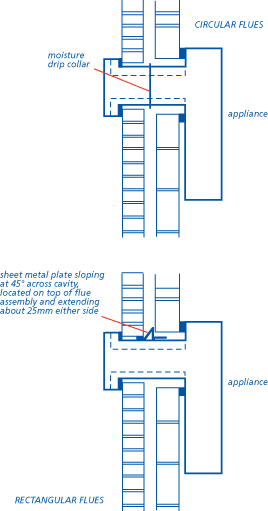
Oil
FIREPLACES AND HEARTHS
Items to be taken into account include:
(a) combustion air
Combustion air is vital to the safe and efficient operation of appliances. Reference should be made to Appendix 6.8-A.
(b) provision of hearths
If the temperature of the hearth below the appliance is likely to exceed 100°C, or the temperature is not known, a hearth should be provided as described for solid fuel appliances. If this temperature is unlikely to be exceeded the appliance may stand on a rigid, non-combustible imperforate sheet of material without a constructional hearth.
(c) shielding appliances
Appliances which are likely to have back or side temperatures exceeding 100°C should be shielded as described for gas appliances (see Clause D9(c)).
FLUE PIPES
Items to be taken into account include:
Flue pipes should be at least the size of the outlet to the appliance. Reference should be made to Appendix 6.8-B.
As for solid fuel.
See Clause D14 (c).
CHIMNEYS
Items to be taken into account include:
Flue sizes should be in accordance with Appendix 6.8-B.
As for gas flues.
Separation should be in accordance with the following table.
As for gas if the flue gases are unlikely to exceed a temperature of 250°C. As for solid fuel if the flue gases are likely to exceed a temperature of 250°C or the temperature is not known.
As for gas flue pipes if the flue gases are unlikely to exceed a temperature of 250°C. As for solid fuel flue pipes if the flue gases are likely to exceed a temperature of 250°C or the temperature is not known.
As for solid fuel.
As for solid fuel.
As for gas flue pipes if the flue gases are unlikely to exceed a temperature of 250°C. As for solid fuel flue pipes if the flue gases are likely to exceed a temperature of 250°C or the temperature is not known.
As for solid fuel if of masonry construction.
This type of chimney should be designed in accordance with BS 4543 : Part 1 to Part 3 BS EN 1859 and installed in accordance with BS 7566: Part 2 or be assessed in accordance with Technical Requirement R3. An operating life of at least 30 years is required. Component systems to be BS 715 installed in accordance with BS 5440.
See Appendix 6.8-F for positions of flue outlets.
All balanced flue terminals should be positioned to allow free intake of air to the appliance.
As for solid fuel if of masonry construction, unless otherwise stated in the appliance manufacturer's instructions, which should be followed.
General
TIMBER FRAME CONSTRUCTION
The design of timber frame construction should ensure that combustible material is either far enough away from heat sources or, where permitted, shielded.
Designers may find the following 'Institution of Gas Engineers' publications useful:
- 'Guide for gas installation in timber framed housing'
- 'Specification for flues for class II appliances in timber framed housing'.
Appendix 6.8-C contains a detail of an external fireplace recess and chimney. Other details for internal chimneys and chimneys in separating walls are available in TRADA publications.
PROVISION OF INFORMATION
For fireplaces and flues the drawings should show:
- position and size of hearths and fireplaces
- position and size of chimneys and flues
- position and proximity of combustible materials
- position and details of flue terminals or outlets
- position of dpcs and flashings
- construction details of fireplace openings and chimney connections
- details of materials to be used
- limitations on the type of appliance or open fire which can be installed or fuel which can be used
- details of tests required on chimneys and flues including who is responsible for carrying them out.
Ensure that design and specification information is issued to site supervisors and relevant specialist subcontractors and/or suppliers.
Where proprietary products are to be used, manufacturers usually have specific requirements for fixing and/or assembly of their products. This information should also be made available for reference on site so that work can be carried out satisfactorily in accordance with the design and specification.





















